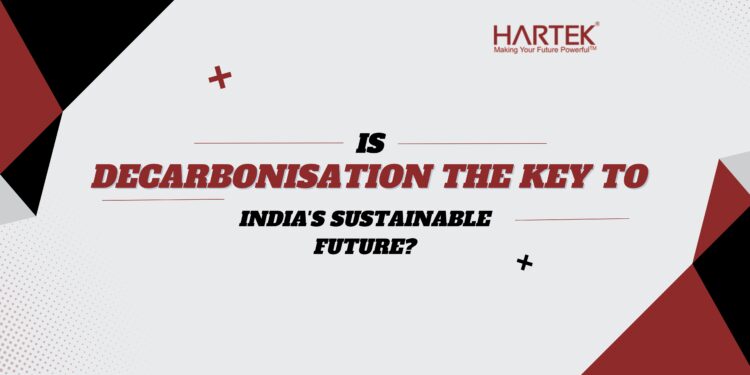The future of India’s economy, environment, and energy systems depends on one crucial strategy decarbonisation as the globe struggles with the urgent effects of climate change. The need for sustainable practices is critical given the growing population and rising energy demand. The importance of grid decarbonization in India is examined in this blog, along with different decarbonization tactics that can be used and how they fit with the country’s decarbonisation goals.
The Current Energy Landscape in India
India’s dependence on fossil fuels for energy generation is the main reason it is the world’s third-largest emitter of carbon dioxide. With coal making up around 70% of the nation’s total electrical generation, it dominates the energy sector. This dependence puts energy security at serious danger and adds to environmental degradation.
But India also has one of the world’s fastest-growing renewable energy sectors. With a goal of 500 GW of non-fossil fuel capacity by 2030, the government has set aggressive goals to raise the proportion of renewable energy in the energy mix. This paves the way for a significant transition to sustainable energy sources.
Understanding Decarbonisation
The process of lowering carbon emissions linked to energy production and consumption is known as decarbonisation. Grid Decarbonisation in India means switching from fossil fuels to cleaner energy sources, increasing energy efficiency, and implementing cutting-edge technologies. A key component of this effort is the decarbonisation of the grid, which entails changing the current electrical infrastructure to facilitate the integration of renewable energy sources and lower carbon footprints.
The Need for Grid Decarbonisation in India
The decarbonisation of the grid is not just an environmental imperative; it is also an economic opportunity. By investing in renewable energy sources, India can reduce its dependence on imported fossil fuels, thereby improving energy security and creating jobs in the green sector. Moreover, with advancements in technology, the cost of renewable energy has plummeted, making it a viable alternative to traditional energy sources.
Benefits of Grid Decarbonisation
- Impact on the environment: Switching to renewable energy greatly lowers greenhouse gas emissions, which is crucial in the fight against climate change.
- Economic Growth: By generating new jobs, especially in the production, installation, and maintenance of renewable energy systems, investments in renewable energy can boost economic growth.
- Energy Security: India can lessen its susceptibility to changes in global energy prices and geopolitical unrest by diversifying its energy sources.
- Benefits to Health: Lowering air pollution from fossil fuels improves public health and lowers medical expenses due to pollution-related diseases.
Decarbonisation Strategies for India
To achieve its decarbonisation targets, India must adopt a multi-faceted approach. Here are some effective decarbonisation strategies that can be implemented:
- Expanding Renewable Energy Capacity: India’s decarbonisation policy is based on increasing its capacity for renewable energy. This covers energy from solar, wind, hydro, and biomass. Significant progress has already been made by government programs like the Wind Energy Mission and the National Solar Mission. By further investing in these sectors, India can enhance its energy mix and reduce carbon emissions.
- Modernising the Grid Infrastructure: A modern, flexible, and smart grid is essential for integrating renewable energy sources. Investments in grid technology, including smart meters, energy storage systems, and demand response mechanisms, can help manage the variability of renewable energy generation. This modernization will also improve grid reliability and efficiency, facilitating a smoother transition to a decarbonised energy system.
- Promoting Energy Efficiency: Energy consumption and related emissions can be considerably decreased by increasing energy efficiency in a variety of sectors, including commercial, residential, and industrial. Important steps in this regard include putting energy-efficient devices into use, doing energy audits, and encouraging energy-saving behaviors.
- Promoting Electric Vehicles: One of the biggest sources of carbon emissions is the transportation industry. This industry’s carbon impact can be greatly decreased by switching to electric vehicles (EVs). To encourage the use of EVs, the government has already put in place programs like the Faster use and Manufacturing of Hybrid and Electric Vehicles (FAME) scheme. Building charging infrastructure is also essential to facilitating this shift.
- Implementing Carbon Pricing: Introducing carbon pricing mechanisms can incentivize businesses to reduce their carbon emissions. By placing a price on carbon, companies will have a financial reason to invest in cleaner technologies and practices, aligning their operations with India’s decarbonisation targets.
Conclusion: A Sustainable Future for India
The decarbonisation process provides an opportunity to transform India’s economic and environmental destiny, not just a technical issue. India can meet its decarbonisation goals, promote economic growth, and enhance public health by giving grid decarbonisation top priority.
India is on the verge of a sustainable energy revolution, so cooperation between the public sector, private sector, and civil society is crucial. By working together, they can put into practice efficient decarbonisation techniques that open the door to a more sustainable and greener future.
In conclusion, India’s embrace of decarbonisation is a step toward a thriving, sustainable future that will benefit everyone. It is our joint duty as participants in this journey to promote and carry out the adjustments required to realize this goal.












































